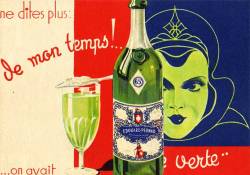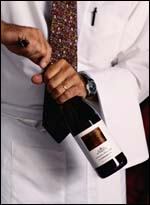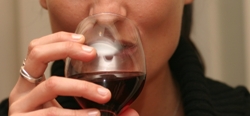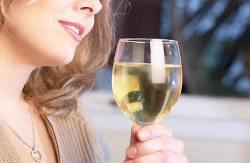 Wherever you can eat you can invariably drink, and vice versa. In France drinking is done at a leisurely pace whether it's before food (apéritif), after (digestif), or during a meal, and cafés is where everyone has a drink.
Wherever you can eat you can invariably drink, and vice versa. In France drinking is done at a leisurely pace whether it's before food (apéritif), after (digestif), or during a meal, and cafés is where everyone has a drink.
Every bar or café has to display the full price list, usually without the fifteen percent service charge added, with the cheapest drinks at the bar (au comptoir), and progressively increasing prices for sitting at a table inside (la salle), or outside (la terrasse). You pay when you leave, and it's perfectly acceptable to sit for hours over just one cup of coffee.
Wine

The price of AOC (appellation d'origine contrôlée) wines can vary from Euro 1.53 to Euro 15.25 and over, and that's the vineyard price. You can buy a very decent bottle of wine for Euro 3.05 or Euro 4.58, and Euro 9.15 and over will buy you something really nice. By the time restaurants have added their considerable mark-up, wine can constitute an alarming proportion of the bill.
The basic wine terms are: brut, very dry; sec, dry; demi-sec, sweet; doux, very sweet; mousseux, sparkling; méthode champenoise, mature and sparkling. There are grape varieties as well, but the complexities of the subject take up volumes. A glass of wine is simply un rouge, un rosé or un blanc. You may have the choice of un ballon (round glass) or a smaller glass (un verre). Un pichet (a pitcher) is normally a quarter-litre. A glass of wine in a bar will cost around Euro 5.58.
 The best way to buy bottles of wine is directly from the producers (vignerons), either at vineyards, at Maisons or Syndicats du Vin (representing a group of wine-producers), or at Coopératifs Vinicoles (wine-producer co-ops). At all these places you can sample the wines first.
The best way to buy bottles of wine is directly from the producers (vignerons), either at vineyards, at Maisons or Syndicats du Vin (representing a group of wine-producers), or at Coopératifs Vinicoles (wine-producer co-ops). At all these places you can sample the wines first.
It's best to make clear at the start how much you want to buy (if it's only one or two bottles) and you will not be popular if you drink several glasses and then leave without making a purchase. The most economical option is to buy en vrac, which you can also do at some wine shops (caves), taking an easily obtainable plastic five- or ten-litre container (usually sold on the premises) and getting it filled straight from the barrel. In cities supermarkets are the best places to buy your wine, and their prices often beat those of the vignerons.
Beer
Familiar light Belgian and German brands, plus French brands from Alsace, account for most of the beer you'll find. Draught beer (à la pression) - usually Kronenbourg - is the cheapest drink you can have next to coffee and wine; ask for un pression or un demi (0.33 litre). A demi costs around Euro 2.59. For a wider choice of draught and bottled beer you need to go to the special beer-drinking establishments or English-style pubs found in most city centres and resorts. A small bottle at one of these places will cost at least twice as much as a demi in a café. In supermarkets, however, bottled or canned beer is exceptionally cheap.
Stronger alcoholic drinks
Strong alcohol is consumed at any time through the day according to circumstance. However, the national reputation for drunkenness has lost much of its truth. Brandies and the dozens of eaux de vie (spirits) and liqueurs are always available.
Pastis - the generic name of aniseed drinks such as Pernod or Ricard and a favourite throughout Languedoc - is served diluted with water and ice (glaçons). It's very refreshing and not expensive. Among less familiar names, try Poire William (pear brandy), or Marc (a spirit distilled from grape pulp). Measures are generous, but they don't come cheap: the same applies for imported spirits like whisky (Scotch).
Two drinks designed to stimulate the appetite - un apéritif - are Pineau (cognac and grape juice) and Kir (white wine with a dash of Cassis - blackcurrant liquor, or with champagne instead of wine for a Kir Royal).
Cocktails are served at most late-night bars, discos and music venues, as well as at upmarket hotel bars and at every seaside promenade café; they usually cost at least Euro 6.90.
Soft drinks
 On the soft drink front, you can buy cartons of unsweetened fruit juice in supermarkets, although in the cafés the bottled (sweetened) nectars such as apricot (jus d'abricot) and blackcurrant (cassis) still hold sway. Other drinks to try are syrups (sirops) of mint, grenadine or other flavours mixed with water. The standard fizzy drinks of lemonade (limonade), Coke (coca) and so forth are all available.
On the soft drink front, you can buy cartons of unsweetened fruit juice in supermarkets, although in the cafés the bottled (sweetened) nectars such as apricot (jus d'abricot) and blackcurrant (cassis) still hold sway. Other drinks to try are syrups (sirops) of mint, grenadine or other flavours mixed with water. The standard fizzy drinks of lemonade (limonade), Coke (coca) and so forth are all available.
Fruit juices
You can also get fresh orange or lemon juice (orange/citron pressé), at a price. A citron pressé is a refreshing choice for the extremely thirsty on a hot day - the lemon juice is served in the bottom of a long ice-filled glass, with a jug of water and a sugar bowl to sweeten it to your taste.
Bottled water
Bottles of mineral water (eau minérale) and spring water (eau de source) - either sparkling (gazeuse) or still (eau plate) - abound, from the big brand names to the most obscure spa product. But there's not much wrong with the tap water (l'eau de robinet) which will always be brought free to your table if you ask for it.
Coffee, tea, and hot drinks
Coffee is invariably espresso - small, black and very strong. Un café or un express is the regular; un crème is with milk; un grand café or un grand crème are large cups. In the morning you could also ask for un café au lait - espresso in a large cup or bowl filled up with hot milk. Un déca is decaffeinated, now widely available.
Ordinary tea (thé) is Lipton's nine times out of ten and is normally served black, and you can usually have a slice of lemon (limon) with it if you want; to have milk with it, ask for un peu de lait frais (some fresh milk). After eating, herb teas (infusions or tisanes), served in every salon de thé, can be soothing. The more common ones are verveine (verbena), tilleul (lime blossom), menthe (mint) and camomille (camomile).
Chocolat chaud - hot chocolate - unlike tea, lives up to the high standards of French food and drink and can be had in any café.
You should follow me on twitter here.
thanl you so much this was a massssive help i think its great theat u can hop on a website and be able to reasearch great ideas like you have on this site THANKS
sazza on 15 September, 2012